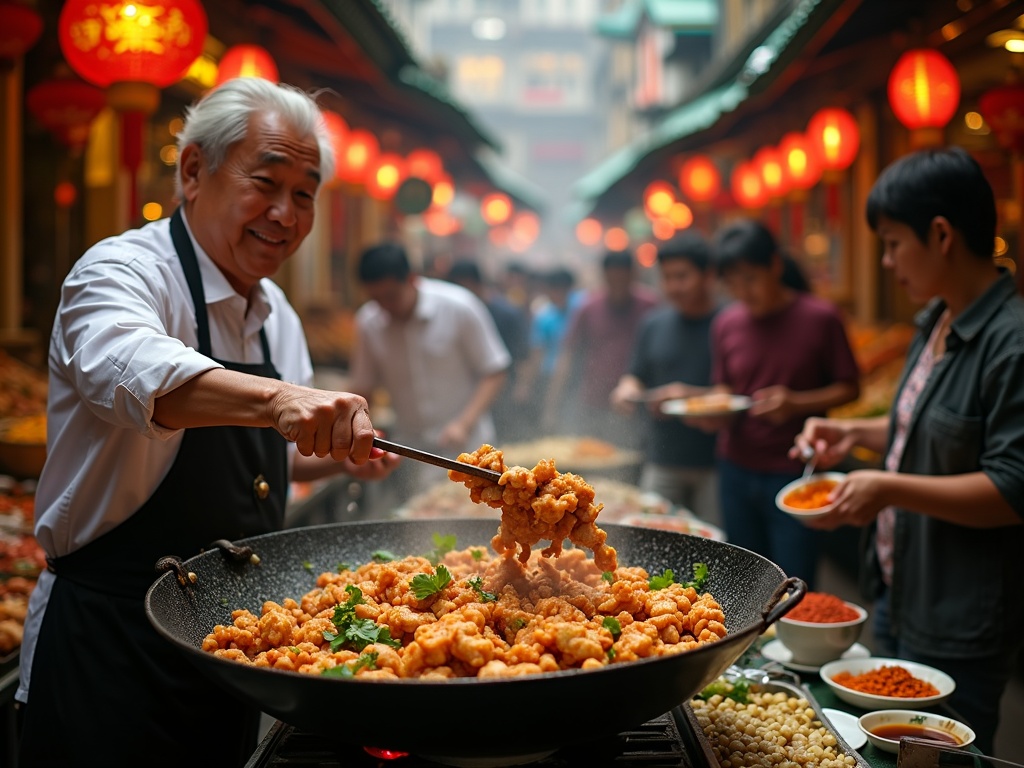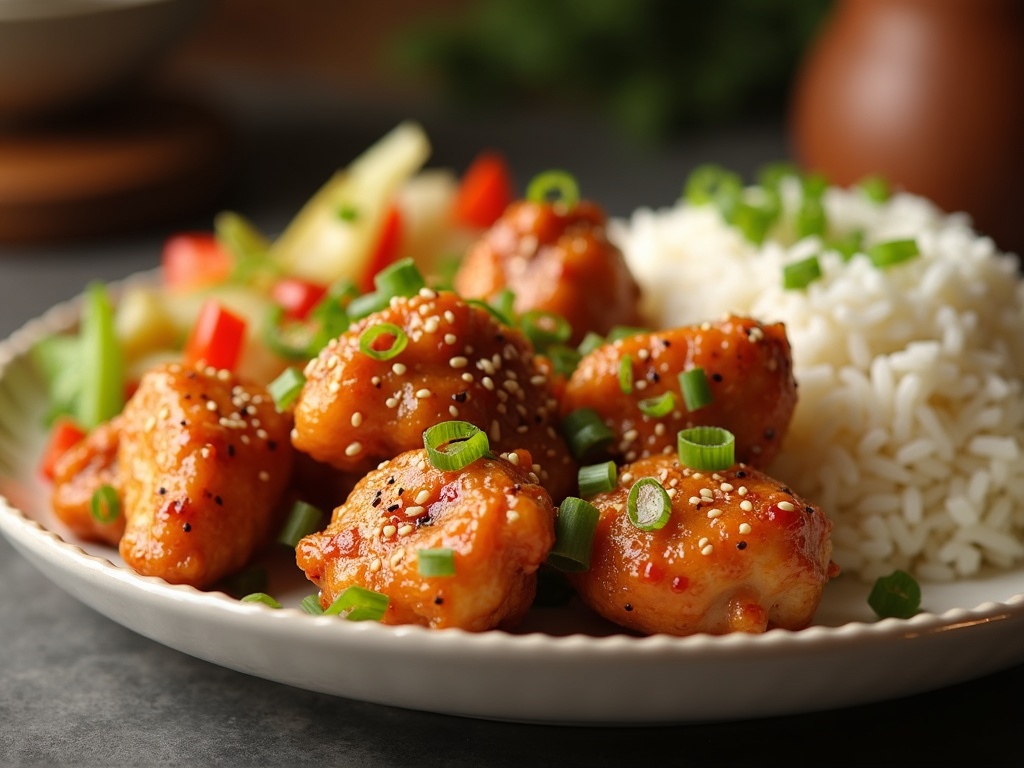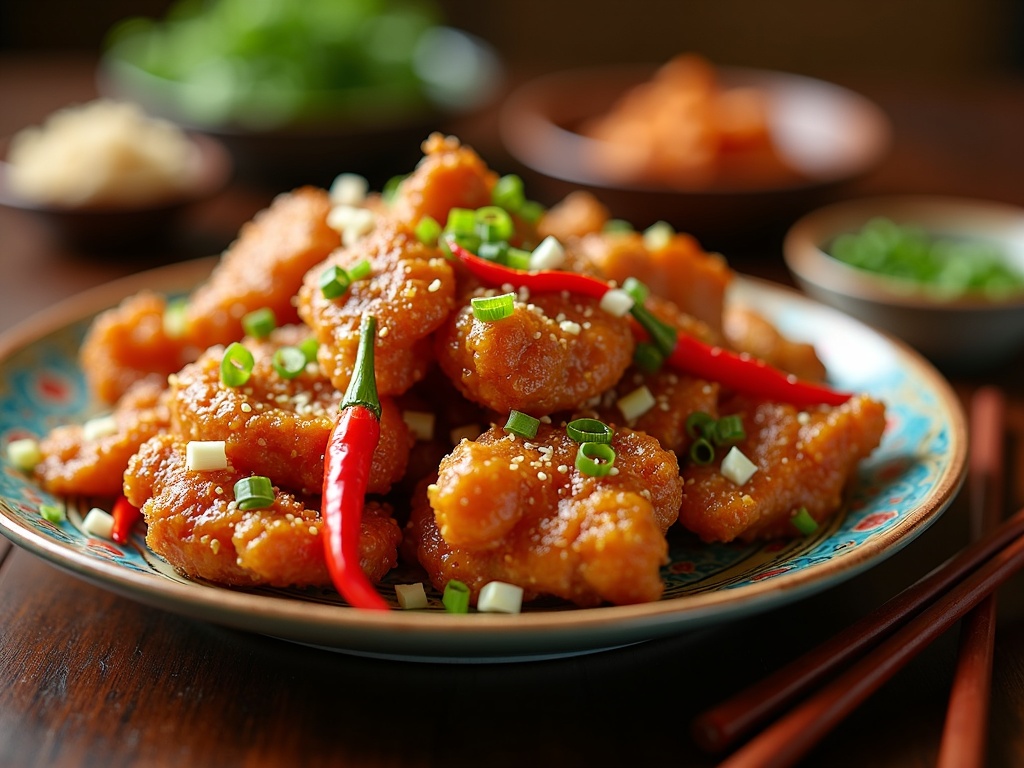Salt and pepper chicken has evolved from its Chinese origins to become a global culinary favorite, captivating food lovers with its perfect balance of crispy texture and bold flavors. The dish showcases the brilliant simplicity of Chinese cooking techniques, turning basic ingredients into an extraordinary experience that appears on restaurant menus worldwide.
Find In This Article
Key Takeaways
- The classic preparation involves chicken pieces coated in light batter, deep-fried, then tossed with a fragrant mix of salt, pepper, and aromatics.
- Air frying offers a healthier alternative that reduces fat content by up to 70% while still maintaining the coveted crispy texture.
- The dish’s perfect balance comes from combining a light, crispy coating with distinctive seasoning and aromatic additions like garlic, chili peppers, and fresh herbs.
- Regional variations exist across different parts of China and other countries, with adaptations incorporating local ingredients while maintaining the dish’s essential character.
- Salt and pepper chicken pairs well with various sides, from steamed rice to vegetable-based options for a more balanced meal.
A Global Sensation: The Story Behind Salt and Pepper Chicken
Salt and pepper chicken has traveled far beyond its Chinese origins to become a global culinary favorite. I’ve watched this dish transform from a regional specialty to a must-have menu item at restaurants worldwide. Its perfect balance of simplicity and bold flavor has captured the hearts of food lovers everywhere.
From China to Your Dinner Table
This crispy delight originated in Chinese cuisine, particularly in Hong Kong and northern China. The dish exemplifies the brilliant simplicity of Chinese cooking techniques, where basic ingredients transform into something extraordinary. What started as a humble street food has evolved into one of the most ordered items at Chinese restaurants globally. According to food industry data, 79% of Americans have tried Chinese food, with Asian cuisine ranking as the most popular ethnic food category in the U.S.
The classic preparation involves chicken pieces coated in a light batter, deep-fried to golden perfection, then tossed with a fragrant mix of salt, pepper, and aromatics. Unlike more sauce-heavy dishes like spicy chilli chicken or aromatic garlic chicken, salt and pepper chicken lets its seasoning speak for itself.
The Perfect Blend of Flavors and Textures
What makes this dish special is its perfect balance of textures and flavors. The key elements include:
- A light, crispy coating that shatters with each bite
- The distinctive salt and pepper seasoning blend
- Aromatic additions like garlic, chili peppers, and five-spice powder
- Freshly fried herbs such as coriander or green onions for brightness
The dish is remarkably versatile, pairing beautifully with steamed rice or appearing alongside noodles in dishes similar to classic chicken chow mein. The cooking technique shares similarities with traditional fried chicken recipes, but with distinctly Chinese flavors.
The popularity of salt and pepper chicken continues to grow, with over 60% of diners seeking it when ordering authentic Chinese takeout. Its appeal crosses cultural boundaries, making it as beloved as other fusion favorites like pesto chicken pasta or tangy buttermilk chicken.
What fascinates me about salt and pepper chicken is how such a simple concept—crispy chicken with salt and pepper—can deliver such a complex and satisfying flavor experience. It proves that sometimes the most straightforward dishes create the most lasting impressions on our palates.

The Perfect Recipe: Essential Ingredients and Measurements
I’ve crafted this salt and pepper chicken recipe through years of testing different ingredient proportions to achieve that perfect balance of flavors. The beauty of this dish lies in its simplicity, where just a few key ingredients create a memorable meal.
Core Ingredients for Authentic Flavor
For this recipe, I recommend starting with 500g of chicken. While both thighs and breasts work well, I find thighs bring extra juiciness and flavor to the garlic-infused chicken dish. The meat should be cut into bite-sized pieces for quick, even cooking.
The coating is where the magic happens. You’ll need 100g of cornflour (cornstarch) which creates that signature light, crispy exterior that makes fried chicken recipes so irresistible. The cornflour needs to be thoroughly seasoned with 5g of salt and 5g of freshly ground black pepper – these measurements are crucial for that perfect flavor balance.
To elevate the taste profile further, I include these additional seasonings:
- Garlic powder (2-3g) for depth of flavor without burning like fresh garlic
- Chili flakes (2-4g depending on heat preference) for a gentle kick
- Five-spice powder (optional, 1g) for authentic Asian notes
The beauty of chilli chicken variations like this is that you can adjust the seasonings to suit your taste preferences. Some home cooks might add a pinch of white pepper or a dash of MSG for that authentic takeaway flavor.
For frying, I use a neutral oil with a high smoke point, such as vegetable or peanut oil. About 500ml is perfect for shallow frying in a wok or deep pan.
When serving this dish, it pairs beautifully with steamed jasmine rice or chicken chow mein for a complete meal. For a lighter option, serve alongside stir-fried vegetables like bell peppers, onions, and spring onions, which complement the crispy chicken perfectly.
This buttermilk chicken alternative offers great nutritional value too. Each 150g serving contains approximately 300 calories, with 15g of protein to keep you satisfied. The fat content is around 15g, while carbohydrates amount to roughly 20g, making it a relatively balanced meal option.
For a complete flavor experience, I sometimes finish the dish with a sprinkle of toasted sesame seeds and finely sliced spring onions. These final touches add freshness and visual appeal to your pesto chicken pasta alternative.
The versatility of this recipe means you can easily scale it up for gatherings or adjust the spice levels to suit everyone at your table. The measured approach to seasonings ensures consistent results every time you prepare this crowd-pleasing dish.

Master Chef Tips: Creating the Perfect Crispy Texture
The secret to outstanding salt and pepper chicken lies in achieving that perfect crispy exterior while keeping the meat juicy inside. I’ve perfected these techniques through years of testing different cooking methods.
Traditional vs. Modern Cooking Methods
Traditional salt and pepper chicken preparation follows a specific process that guarantees exceptional results. First, I marinate the chicken pieces in a mixture of soy sauce, ginger, and a touch of rice wine to infuse flavor. After marinating, I thoroughly coat the chicken in cornflour, which creates that signature crispy coating that makes this dish so popular.
Deep frying is the classic cooking method, taking about 10-15 minutes until the chicken turns a beautiful golden brown color. The rapid heat from the oil creates a crisp outer layer while sealing in moisture. The key is maintaining the oil at around 350°F (175°C) for consistent results.
If you’re looking for a healthier alternative, air frying has become increasingly popular. This modern approach reduces oil content by approximately 70% while still delivering impressive crispiness. I’ve found that a light spray of oil on the coated chicken before air frying helps achieve results closer to the traditional method.
Both cooking techniques achieve the desired crispiness, though each offers slightly different benefits:
- Deep frying provides that authentic restaurant-style texture and flavor
- Air frying offers a healthier option with significantly less oil
- Conventional oven baking works in a pinch but requires a higher temperature
- Shallow frying splits the difference between full deep frying and air frying
Regional preparations vary significantly across different parts of China and other Asian countries. Some versions include bell peppers and onions stir-fried with the crispy chicken, while others focus solely on the seasoned meat. The Hong Kong style typically features a drier, more intensely seasoned coating, while Taiwanese versions often incorporate basil and other aromatic herbs.
For the best results with crispy chicken dishes, I recommend these professional tips:
- Pat chicken completely dry before coating to improve adhesion
- Let coated chicken rest for 5-10 minutes before frying
- Cook in small batches to maintain oil temperature
- Drain on paper towels immediately after cooking
- Season while still hot for maximum flavor absorption
- Serve immediately for optimal texture
When you’re looking to expand your chicken recipe collection, I suggest trying chilli chicken or chicken chow mein which use similar preparation techniques but with different flavor profiles.
The crispiness factor can be maintained even when making larger batches for family gatherings. I keep the first batches warm in a low oven (around 200°F) while finishing the remaining chicken. This maintains the crunch without drying out the meat.
For a complete meal, this crispy chicken pairs perfectly with simple steamed rice or chicken pasta dishes for fusion cuisine. Some home cooks even incorporate the techniques from buttermilk chicken preparation by soaking the chicken in buttermilk before coating for extra tenderness.
Whether you’re cooking for yourself or entertaining guests, mastering the crispy texture of salt and pepper chicken will make you feel like a professional chef in your own kitchen.
Health-Conscious Alternatives
Making healthier versions of salt and pepper chicken doesn’t mean sacrificing flavor. I’ve discovered several ways to enjoy this delicious dish while keeping nutrition in mind.
Smarter Cooking Methods
The air fryer has revolutionized how I prepare salt and pepper chicken. By using just a light spray of oil instead of deep-frying, I can reduce the fat content by up to 70% while maintaining that coveted crispy exterior. The circulating hot air creates a similar texture to traditional frying but with significantly less oil absorption.
Using skinless chicken pieces further reduces the fat content. Chicken breast is particularly lean, providing approximately 31g of protein per 100g serving with minimal fat. I’ve found that marinating skinless pieces in a touch of olive oil with the salt and pepper seasonings helps retain moisture during cooking.
The cooking method dramatically impacts the final nutritional profile. While deep-fried versions can contain upwards of 400 calories per serving, air-fried alternatives typically range between 220-250 calories. Oven-baked versions fall somewhere in the middle at around 300 calories per serving.
Balanced Meal Planning
Creating a well-rounded meal involves considering what accompanies your garlic infused chicken dish. I recommend these nutrient-rich side options:
- Steamed broccoli or green beans for added fiber and vitamins
- Cauliflower rice instead of white rice to reduce carbohydrates
- Mixed green salad with a light vinaigrette for additional nutrients
- Roasted sweet potatoes for complex carbohydrates and vitamins
The protein-to-carbohydrate ratio can be optimized by adjusting your sides. A typical serving of homemade fried chicken provides excellent protein, so pairing it with vegetable-based sides creates balance.
For those with dietary restrictions, this dish adapts well. Gluten-free coatings like rice flour or cornstarch work perfectly for the crispy exterior. The simple seasonings make it ideal for those following low-carb or paleo approaches.
I’ve also found that buttermilk chicken techniques can be adapted by using yogurt marinades instead, which tenderizes the meat while adding beneficial probiotics. For a complete meal makeover, consider transforming the concept into a pesto chicken pasta with whole grain noodles and added vegetables.
By making thoughtful adjustments to traditional salt and pepper chicken, I can enjoy this classic dish while supporting my health goals.

Cultural Impact and Global Appeal
Salt and pepper chicken stands as a delicious testament to the incredible reach of Chinese cuisine around the world. I’ve noticed how this simple yet flavorful dish has crossed continents and cultural boundaries, becoming a staple in Chinese restaurants globally while adapting to local tastes.
From China to the World
The journey of salt and pepper fried chicken reflects centuries of culinary exchange. Chinese immigrants brought their cooking techniques and flavor profiles to new shores, introducing local populations to the magic of wok cooking and the perfect balance of salt and peppery heat. What began in Cantonese kitchens has transformed into a dish that feels at home on menus from London to Sydney.
The dish beautifully showcases how migration patterns have shaped global food culture. In areas with significant Chinese diaspora communities like San Francisco, Vancouver, and Manchester, salt and pepper chicken evolved to incorporate local ingredients while maintaining its essential character. This adaptability helps explain why it’s become such a crowd-pleaser internationally.
Contemporary Adaptations
Today’s salt and pepper chicken demonstrates an exciting fusion of traditional Chinese cooking methods with contemporary approaches. The core elements remain consistent:
- Crispy chicken pieces tossed with aromatic salt and pepper seasoning
- The signature texture contrast between crunchy exterior and tender meat
- The aromatic blend of garlic, chili, and spring onions
However, regional variations have emerged that keep the dish fresh and relevant. In the UK, garlic chicken variations might include more pronounced heat levels, while American versions often feature larger chicken pieces and sometimes sweet elements to balance the spice.
Salt and pepper chicken has earned its place as a staple on Western Chinese restaurant menus, often appearing alongside dishes like chicken chow mein and sweet and sour options. Its broad appeal comes from hitting that perfect balance – offering enough authentic Chinese flavors to feel special while remaining accessible to Western palates.
The dish has even influenced fusion cooking, with creative chefs incorporating the salt and pepper seasoning profile into everything from chicken pasta dishes to french fries. This culinary cross-pollination shows how a relatively simple concept can spark creativity across different food traditions.
What makes salt and pepper chicken particularly fascinating is how it represents the evolution of Chinese cuisine abroad. Unlike some heavily adapted dishes that bear little resemblance to their origins, salt and pepper chicken maintains its authentic roots while embracing subtle changes that help it thrive in new environments.
In many ways, this dish serves as a gateway to Chinese flavors for those who might be hesitant to try more unfamiliar options like chilli chicken with its more complex spice profiles. The approachable combination of crispy chicken with salt, pepper, and aromatic vegetables offers an easy entry point to explore more diverse Chinese flavors.
The global popularity of salt and pepper chicken has also led to increased interest in Chinese cooking techniques at home. Home cooks worldwide now attempt to recreate this restaurant favorite, learning about proper wok cooking, the importance of dry-brining with salt, and how to achieve the perfect crispy coating similar to buttermilk chicken preparations.
As international cuisine continues to evolve, salt and pepper chicken stands as a perfect example of how food transcends borders, bringing people together through shared culinary experiences. Its journey from Cantonese kitchens to global favorite shows how the best dishes don’t just travel well – they thrive by adapting while honoring their origins.
Sources:
“The Gastronomy of Chinese Cuisine,” National Geographic
“Nutritional Analysis of Fried Foods,” Journal of Food Science
“The Rise of Asian Cuisine in America,” Pew Research Center
“Cooking Techniques in Asian Cuisine,” The Culinary Institute of America

